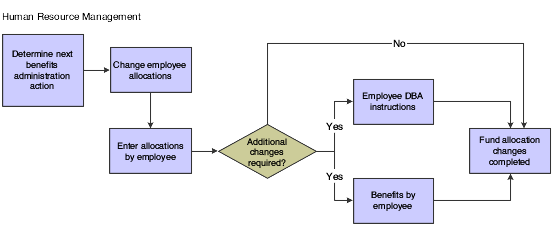Understanding Fund Allocations
Many companies offer employees a variety of options for retirement or investment plans, such as 401(k) plans. To set up a retirement or investment plan that includes several investment options, you set up each option as a separate accrual.
When you enroll an employee in a retirement or investment plan, you identify the percentage or amount of the contribution from the employee's wages and any percentage or amount that the employer contributes. After you enroll an employee in the retirement or investment plan, you create fund allocations to define how the system distributes that total contribution among the available investment options.
To define the way in which an employee distributes funds among investment options, you must add a new allocation. You also specify the percentage of the total contribution that the employee contributes to each investment program.
You change a fund allocation whenever an employee changes an allocation among the investment programs that the company offers. The employee can allocate funds among all available investment programs, but the total must equal 100 percent.
The new allocations begin on the new start date. The previous allocations end one day before the new start date.
An employee might request that you revise fund allocation percentages or start dates. You can revise this information for the upcoming pay period only if the system has not yet made a deduction from the employee's pay. When any pre-payroll processing has occurred, you cannot revise the fund allocation, but must make a new allocation.
This graphic illustrates the process for changing fund allocations:
